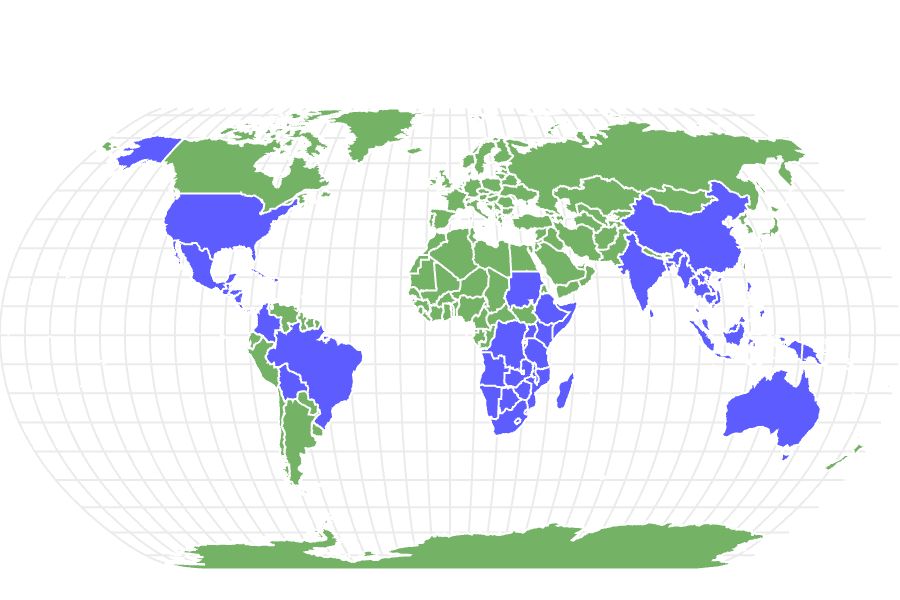Blind Snake
The blind snake is often mistaken for a worm.
Advertisement
Blind Snake Scientific Classification
Read our Complete Guide to Classification of Animals.
Blind Snake Conservation Status
Blind Snake Facts
- Prey
- Ants, termites, other invertebrates.
- Fun Fact
- The blind snake is often mistaken for a worm.
- Litter Size
- Up to 7 eggs
Blind Snake Physical Characteristics
- Color
- Grey
- Pink
- Skin Type
- Scales
- Length
- 14 - 30 cm (or 5.5 - 12 inches)
- Venomous
- No
- Aggression
- Low
View all of the Blind Snake images!
The blind snake is often mistaken for a worm, even with hundreds of different species.
It can reach up to 3.3 feet long, though most of them are no more than about half a foot long in their adult size. Some species of this snake can lay eggs that hatch without fertilization, keeping their population steady. However, an estimated number is not available because they all live underground.
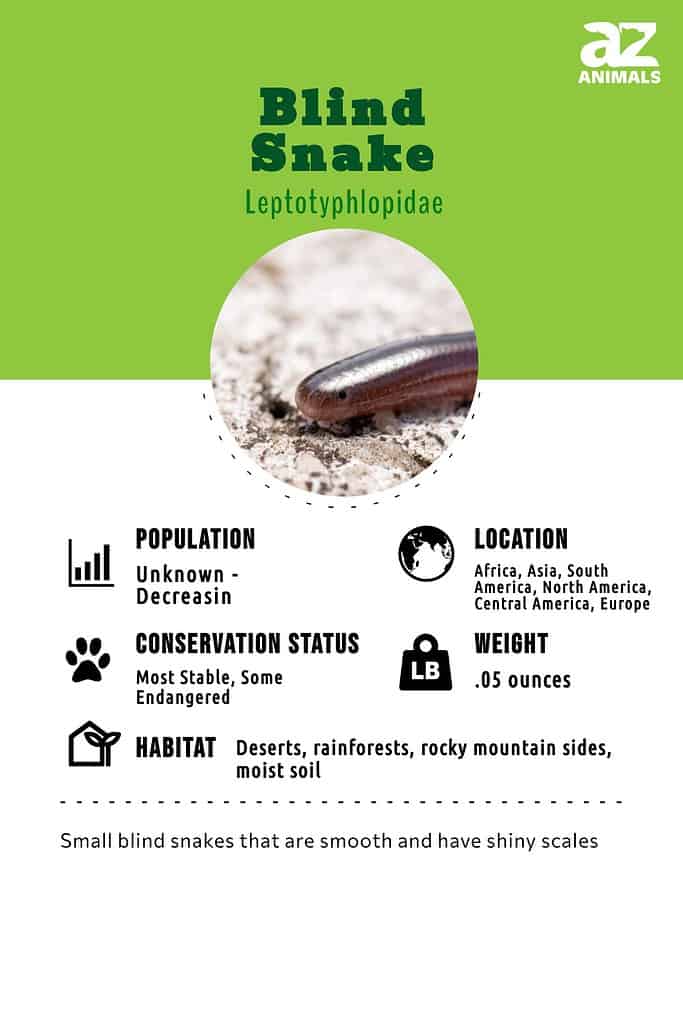
5 Amazing Facts
- The blind snake family consists of 18 genera and over 200 individual species.
- The tail of every blind snake has a horned scale.
- While the majority of blind snake species are found in tropical habitats, the flowerpot snake is found primarily on islands around the world as well.
- The Brahminy blind snake is exclusively female, and it lays eggs that are self-activated in development rather than fertilized. Even if only one were left, it could create a new population.
- Blind snakes are non-venomous.
Where to Find Them
Since there are so many blind snakes around the world, they are found on every single continent, though they prefer to live in tropical areas. In fact, according to many researchers, these blind snakes are in every tropical area.
They can be found in tropical areas in Africa and Asia and South and Central America. However, the Bimini island of the Caribbean is primarily home to pink blind snakes.
Despite being found across the world, no snakes at all are found in Ireland, but European countries with a tropical zone have found blind snakes in their regions as well. Since they prefer a wetter climate, the easiest time to spot them in these habitats is after heavy rain. Sometimes, they’ll reside in trees to give them access to ants and termites as their food.
With over 200 species in 18 genera, the specific location depends on the species.
Types of Blind Snakes
Blind snakes come down to 18 genera, though some of the most commonly known snakes within this family include the:
- Brahminy blind snake: The Brahminy blind snake primarily lives in southeast Asia, but they’ve also been found in Florida since the 1970s. Instead of being pink, this snake is so dark that it appears to be black, and they grow to be about 7 inches long at its full size.
- Texas blind snake: The Texas blind snake is brown, and it is also called the Texas thread snake or the Texas slender blind snake. They range from 3 to 13 inches long, and they are found throughout the state that they are named for, even though it is not tropical.
- Western blind snake: The western blind snake is bright pink, and it is found throughout California. It doesn’t have much of a neck, and it is incredibly small.
Scientific Name
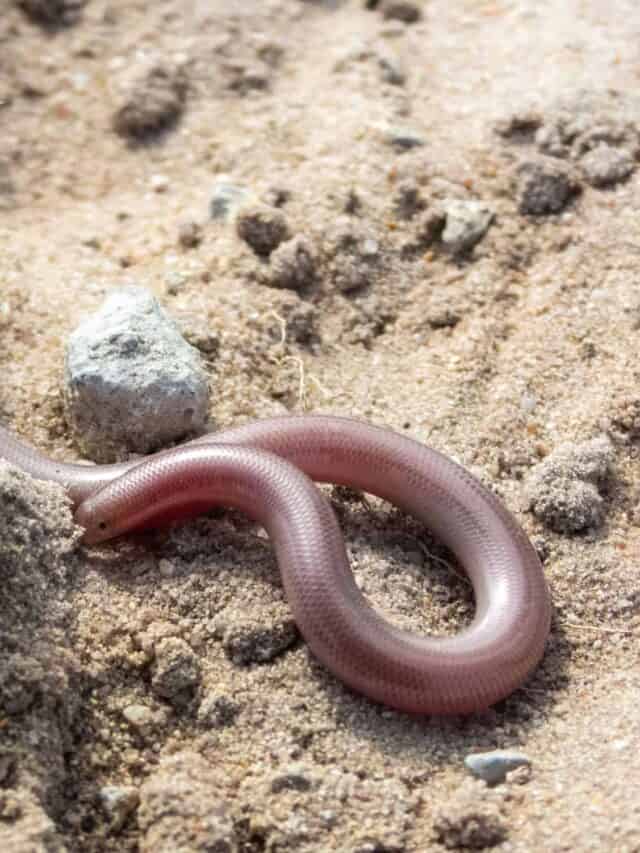
Blind snakes are also called worm snakes and thread snakes.
©Willem Van Zyl/Shutterstock.com
The blind snake, superfamily Typhlopoidea, is known by the scientific name Typhlopidae. There are 250 nominate species under this family, which is under the Reptilia class. The word “Typhlopidae” comes from the Greek words “tuphlós” and “ṓps,” translating to mean “blind eye.”
Blind snakes belong to the families Anomalepidae, Leptotyphlopidae, and Typhlopidae.
Some common species include the Texas blind snake, the western blind snake, and the Brahminy blind snake.
Population and Conservation Status
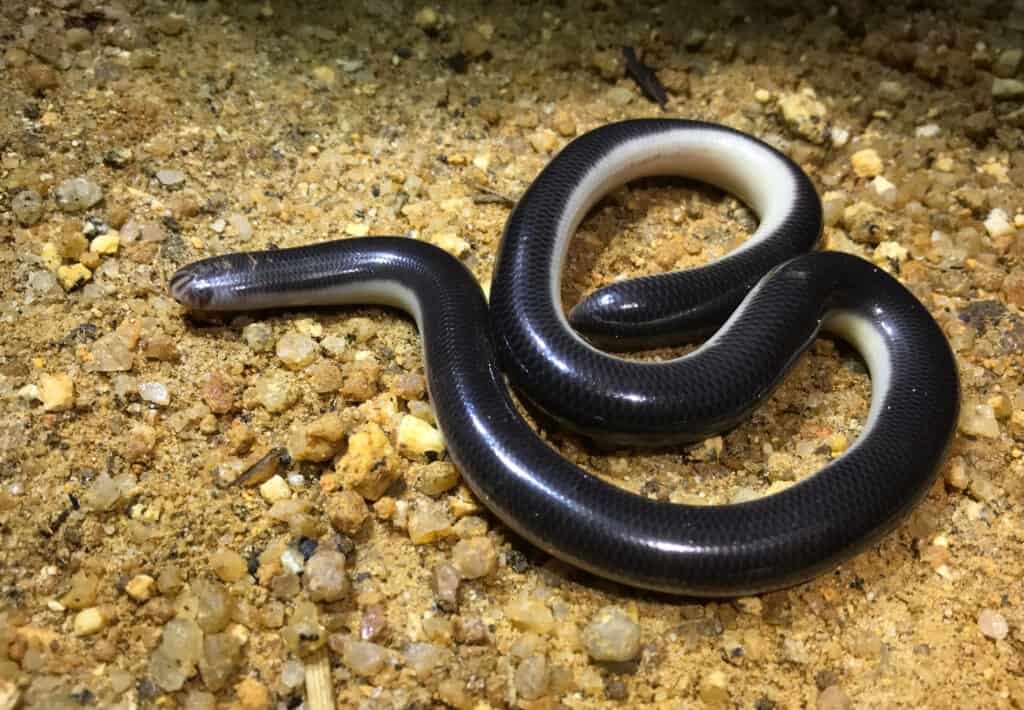
Some species of blind snakes are threatened, stable, or endangered.
©Huy Nguyen Ngoc Xuan/Shutterstock.com
The entire blind snake family comes down to about 250 species, but their subterranean nature makes it difficult for researchers to determine an estimated population. For the most part, the IUCN says that blind snakes are considered to be “Not Extinct.” There are a few species that are of Least Concern (Bismarck sharp-nosed blind snake, Liwale blind snake, and the Costa Rica worm snake), and multiple extinct species. The Madagascar blind snake, however, is currently considered Critically Endangered.
Appearance and Description
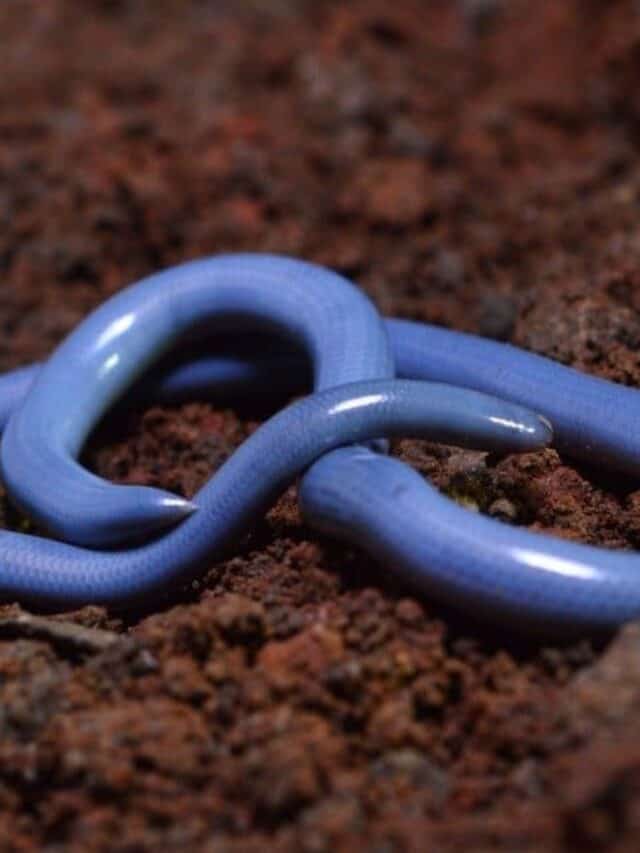
Thin and tiny, the Brahminy blind snake is sometimes mistaken for a baby snake of another species.
©RealityImages/Shutterstock.com
Since there are so many different species, it is hard to say a specific description for all of them. Most of these snakes have teeth in their upper jaw and black spots in the eye to make it easier to see in the dark burrows in which they live. They have no real use for their vision, and they have cylindrical bodies with short tails and blunt heads. Their scales are smooth and shiny. Most of these snakes have a rather small size, ranging from 5.5 to 12 inches, though some species could reach up to 3.3 feet. They look like worms, often featuring a gray or pink body. Pink blind snakes are more likely to be found on Bimini in the Caribbean, though the brown blind snake is often mistaken for an earthworm.
How to identify blind snakes:
- Up to 3.3 feet long, though typically measures 5-12 inches in overall size.
- Pink or grey body with smooth scales.
- Blunt head with a short tail.
- Looks fairly similar to a worm.
Diet
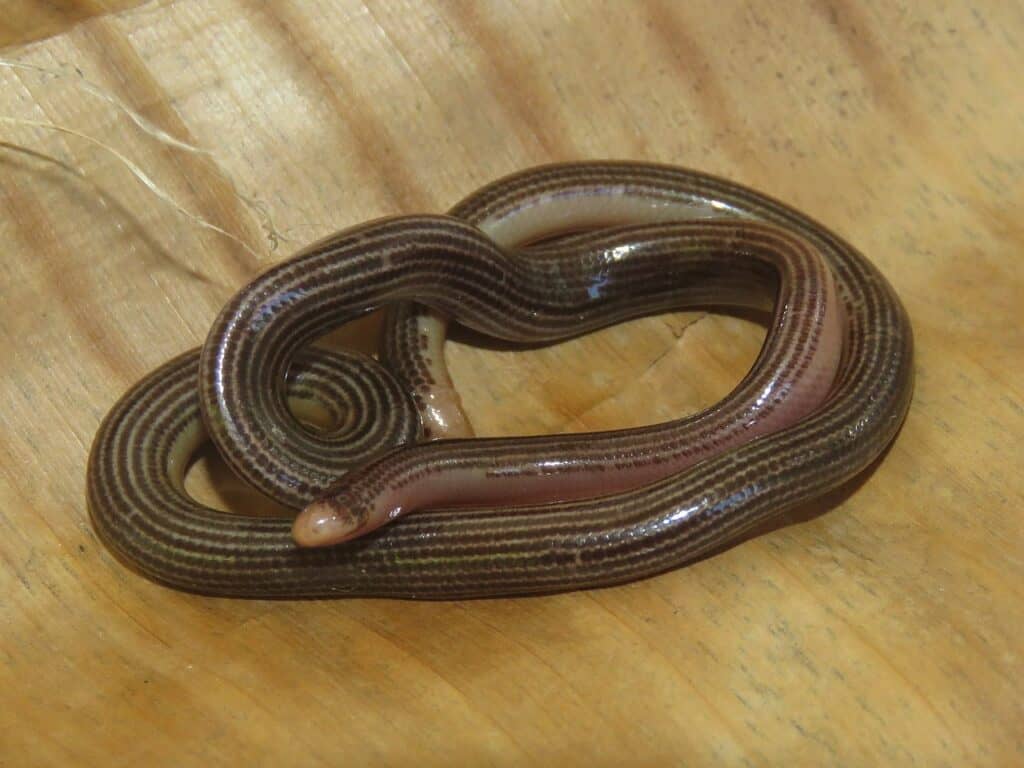
Currently listed as endangered, the Trinidad blind snake lives in only a few places on Earth
©Mike G. Rutherford / Creative Commons – License
Blind snakes consume small creatures without spinal columns, such as bugs, spiders, daddy longlegs, centipedes, and millipedes. Most of these species favor ants and termites, but many of them will eat almost anything, including caterpillars, fly maggots, beetles, cockroaches, and crickets.
Blind snakes are able to track down ant and termite hills by following the scent that the insects leave on the ground. Once the snake finds the hill, it slips inside and eats as much as it can. They specifically enjoy consuming ant eggs, pupae, and larvae. The lower jaw of these slender creatures can be extended and retracted rapidly, which allows them to feast on many eggs, larvae, and pupae in a very brief period.
The blind snake is able to protect itself from ants, which are known for their aggressive defense of their nests. When confronted, the snake curls into a ball and covers itself with a mixture of slime and feces. The foul-smelling substance scares away the ants, allowing the snake to go back to its meal.
Pictures

©Ken Griffiths/Shutterstock.com
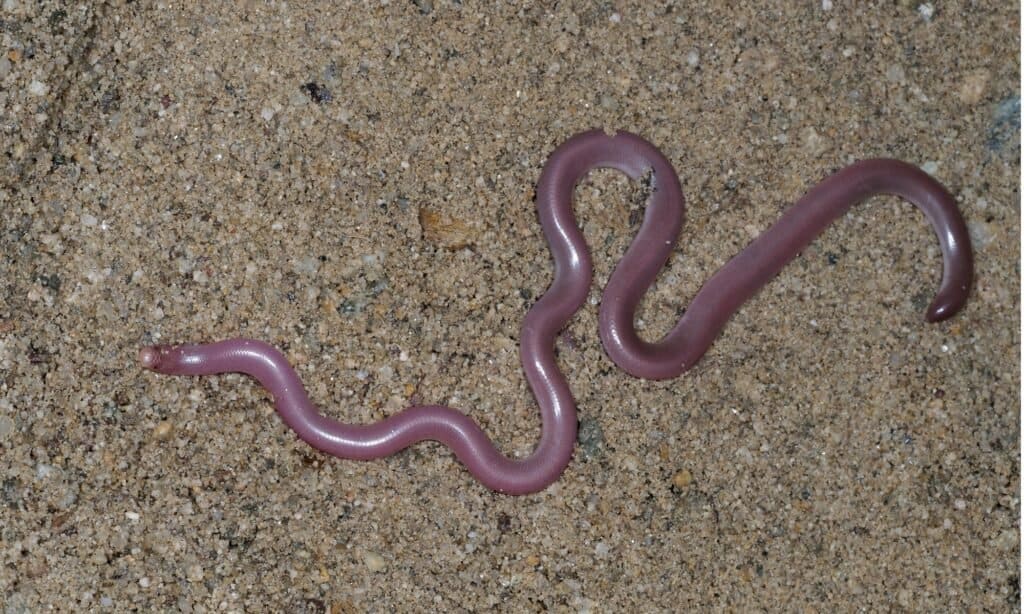
©iStock.com/MikeLane45
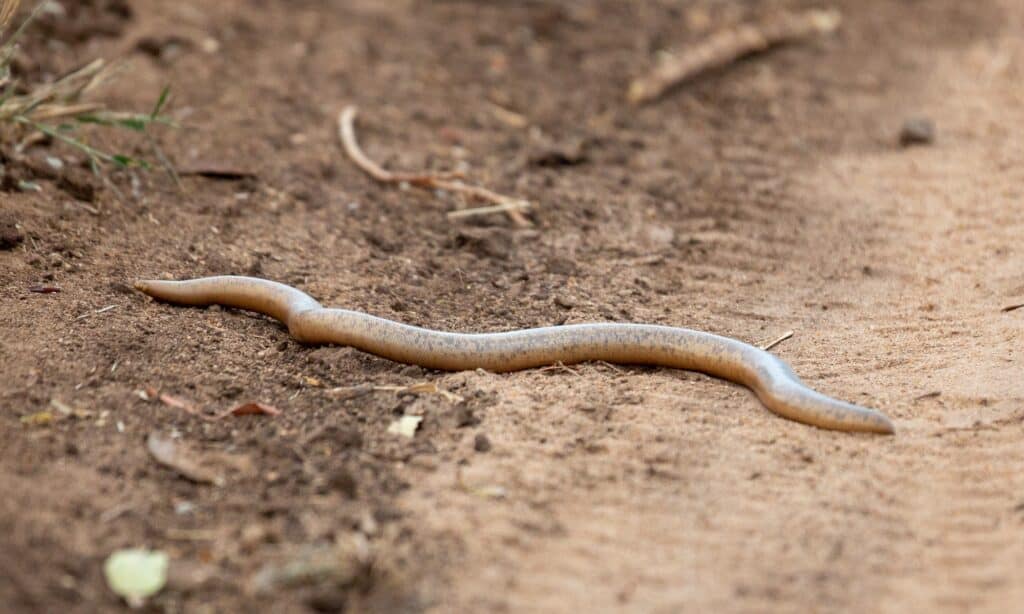
.
©iStock.com/DarrelCamden-Smith
Venom: How Dangerous Are They?
Since blind snakes carry no venom, they aren’t really harmful at all. They burrow underground, though their take has a sharp spine at the tip that can be intimidating. They have teeth on their upper jaw, but their mouth is such a small size that they can’t open it any larger than what it would take to eat its typical food of ants and termites. There’s no risk of being bitten.
Reproduction and Lifecycle
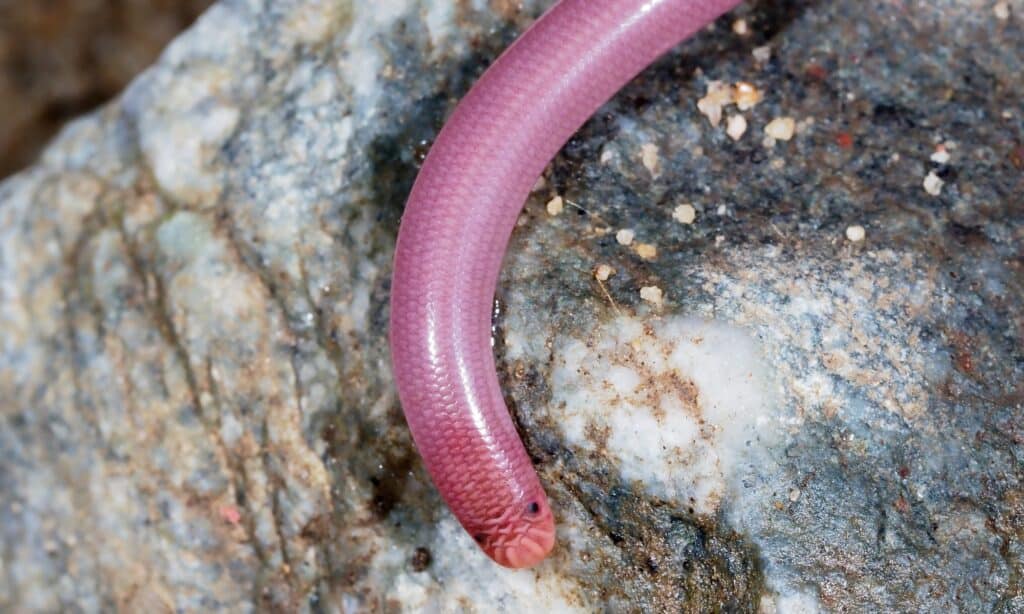
Blind snakes live underground in soft soils, between plant roots and under stones.
©iStock.com/MikeLane45
Blind snakes reproduce sexually, with males using a modified limb called the hemipenis to inseminate females. The female will lay a clutch of two to ten eggs at a time; these take approximately one month to hatch. The newborns are independent from birth and measure around 4 inches.
The lifespan of blind snakes can range from 4-20 years, depending on the species, although some may live even longer. They generally inhabit tropical regions and spend most of their lives underground or in leaf litter, emerging only occasionally for food or during the breeding season. Due to their subterranean lifestyle, they have adapted over time by developing an acute sense of smell which allows them to detect prey such as insects and earthworms. Blind snakes also benefit from having no eyes since this reduces water loss through evaporation when burrowing in dry soil conditions.
Behavior and Humans
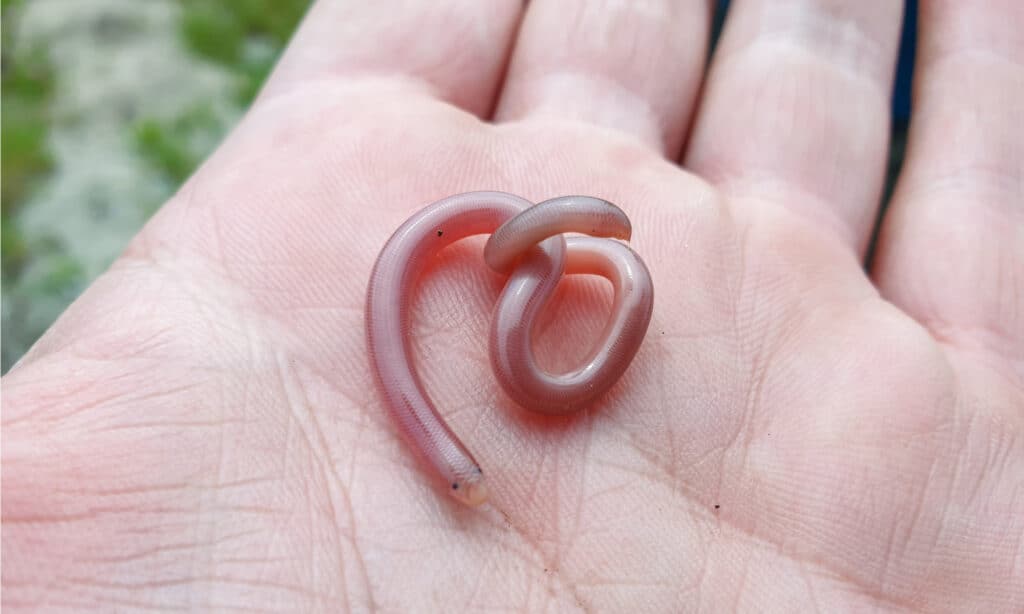
Blind snakes are often mistaken for worms. They are shy and like to stay underground.
©Willem Van Zyl/Shutterstock.com
Blind snakes stay underground, and they are incredibly shy around anyone. When they encounter a human, their main inclination is to get away (instead of bite). Some people may keep the blind snake as a pet, but they aren’t very interactive or outgoing, so they may not be entertaining. Plus, since they are non-venomous and aren’t aggressive, they don’t bite anything more than their small prey.
Predators and Threats

Brahminy Blindsnakes are small, thin, and shiny silver gray, charcoal gray, or purple.
©Radiant Reptilia/Shutterstock.com
The main predators of the blind snake are birds, cats, and other small mammals. They will usually hunt for them in their burrows or when they come to the surface to feed. Other potential threats include habitat destruction due to human activities such as land clearing and urban development, which can reduce food sources for the snakes and make it harder for them to find shelter or cover from predators. Climate change is also a threat, as rising temperatures can cause droughts that result in decreased prey availability for blind snakes.
View all 285 animals that start with BBlind Snake FAQs (Frequently Asked Questions)
Is a blind snake venomous?
No. No species of blind snake is venomous. It is relatively harmless.
Can you keep a blind snake as a pet?
The main appeal to the blind snake is that they aren’t venomous and don’t require much space. There’s not much of a pet trade for these reptiles, but some breeders will sell them as an option for Herpetoculture enthusiasts.
Are blind snakes rare?
Not exactly. There are hundreds of species found around the world in tropical climates, but they are primarily found underground unless there is heavy rain.
Why is it called the blind snake?
Blind snakes live underground in the dark. Though they only have enough vision to see in the dark, they don’t have enough clarity to see the detail that other animals do. Their vision is no more than what they need for survival.
How do blind snakes hunt?
Blind snakes seek out ants and termites as their main food. They cannot dislocate their jaw or attack with a bite. However, their mouth is just big enough to eat these invertebrates.
Are blind snakes aggressive?
No. Blind snakes primarily focus on finding food and staying away from any predators or humans. They can’t really see any threats to their health, but their small size keeps them safely underground in tunnels.
Where do blind snakes live?
Blind snakes prefer to live in tropical climates around the world. In fact, the only area that they are not found in is Antarctica because of the lack of adequate climate. They are found on every other continent, though the species in that area varies. On Bimini (in the Caribbean), pink blind snakes are more common.
What do blind snakes eat?
The primary food of the blind snake is ants and termites, consuming their larvae and eggs.
Thank you for reading! Have some feedback for us? Contact the AZ Animals editorial team.
Sources
- Wikipedia, Available here: https://en.wikipedia.org/wiki/Typhlopidae
- Britannica, Available here: https://www.britannica.com/animal/blind-snake
- Queensland Museum, Available here: https://www.qm.qld.gov.au/Explore/Find+out+about/Animals+of+Queensland/Reptiles/Snakes/Blind+Snakes+Typhlopidae
- Kidadl, Available here: https://kidadl.com/animal-facts/blind-snake-facts

